This crow-sized bird is native to North America and typically found in deciduous tree woods near open meadows which would provide for a diverse array of passerine birds to prey on. It is not a traditional bird in falconry as it does not exist in the wild in Europe, but it has been used for falconry.
Plumage
The immature Cooper's is a creamy white with thin dark streaks down her chest. The upper parts are all various shades and speckles of brown with yellow eyes. The immature bird is frequently mistaken for the immature Goshawk.
The adult Cooper's Hawk has speckles on the chest and a grey-blue back, wings, and tail with a dark cap on the head. The tail has wide bands across it. The eyes are orange turning red as the bird ages.
 |
An immature Cooper's Hawk |
 |
An immature Cooper's Hawk |
 |
An immature Cooper's Hawk |
 |
A mature Cooper's Hawk |
Morphology
The body form of the Cooper's, as with all Accipiters, is marked by a long tail. The tail acts as a rudder to steer the bird during their quick forward flight and acceleration. Contrast that with the soaring Red-Tail, the Accipiters in general need a longer tail for their flight style.
A typical female Coopers' Hawk might fly somewhere around 550 grams down to 370 grams, and a male between 230 grams to 350 grams.
The Sharp-Shin and the Cooper's hawk are sometimes confused, and a small male will be nearly identical in size to a large female Sharp-shin. If looking at the two in profile, the Cooper's will be slightly larger and have the appearance of a more flat head and a more pronounced brow. The Sharp-Shin will have a more rounded head and a less pronounced brow. The Sharp-Shin also have a more square tail while the Cooper's appears much more rounded.
One interesting note about the Cooper's Hawk is that there is a small knob under the third digit which is unique to this bird. This stubby knob is a giveaway that the accipiter is definitely a Cooper's Hawk.
 |
The knob under the third digit of a Cooper's Hawk foot. |
 |
The neck of a dead Cooper's Hawk (3/8" diameter) shown for comparison next to an American Nickel and a neck bell tie.
Photo courtesy of Gaylen Gerrish. |
Hunting
Typical quarry caught with the Cooper's Hawk will be starlings, sparrow, quail, and other small or medium birds; a large female can take cottontail rabbits or Ruffed Grouse. It is known as being fierce when hunting often taking prey much larger than it including grouse, rabbits, reptiles, quail, and chickens. It will perch in a tree near a clearing and wait for prey or fly along a line of trees or a hedge then suddenly flick over the top to surprise a bird, or will approach a group of birds low just grazing the top of the ground suddenly dashing into a flock of feeding birds. Its flight style is marked by alternating flapping quickly and then gliding in a flap-flap-glide sort of style. Noted also for being likely to refuse a slip or turn tail. Because of this falconers have developed the jangoli as a way to help propel these birds to jumpstart a flight and increase their chance of success.
Trivia
The Cooper's Hawk is also referred to as a Coops, Big Blue Darter, or the Chicken Hawk, a name that has come from years of being the bane of poultry farmers.
This bird does best on a diet of sparrows, pigeon, and starling. These birds are sometimes considered "hot" and in need of a richer diet.
As Accipiters go, the Cooper's Hawk prefers slightly warmer and more southerly locations than many other members of this family. It is also sensitive to apoplectic fits.
The tongue is dark, almost a blue color, which is normal for this bird. Chicks have a noticeable purplish, almost black, interior of the mouth and the nodule on their middle toe will be very prominent.
Many falconers note the different head shapes that males and female Accipiters have. Males tend to have a rounder head while female heads are described as more wedge-shaped when viewed from above. In other words, the distance from the center of the top of the head to the cere is shorter in males than in the females causing the female head to appear wedge-shaped and the male head to be more rounded in the front. Females are also noted to have more hooked shape to their beaks.
Since this bird is naturally oriented towards non-game birds, it can be difficult to fly and get quarry for her.
Cooper's Hawks typically have a clutch size of only 2 or 3 eggs. It may reuse nests, take old crow nests, or build a nest.
Links
https://www.hawk-conservancy.org/priors/coopers.shtml
http://www.nenature.com/CoopersHawk.htm
http://birdsbybent.com/ch1-10/coopers.html